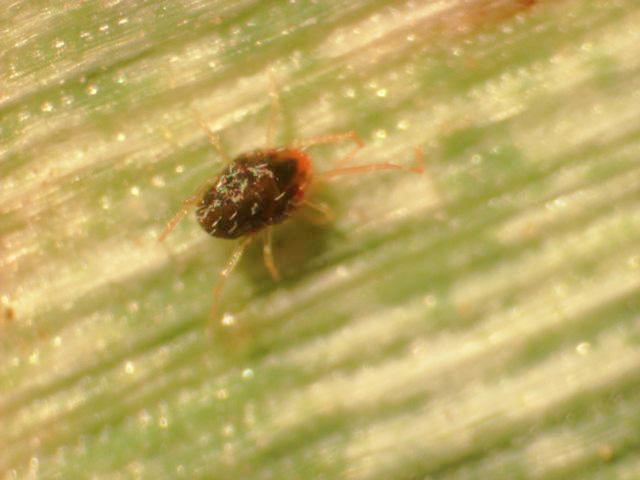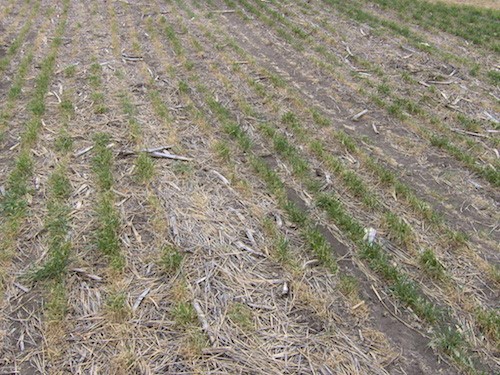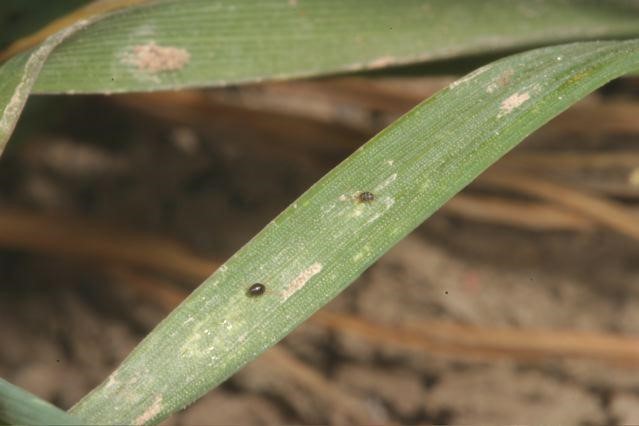Reports of brown wheat mite outbreaks have come in from southwest and northwest Kansas in the last two weeks and the climate outlook for the region is likely to favor continued issues with this pest.
Brown wheat mite (Figure 1) is a sporadic pest of wheat in western Kansas but can also become problematic in eastern Kansas during dry years. Typically, continuous wheat faces a higher risk of damage from this pest and injury can be confused with drought stress. Mites damage individual cells in the leaf causing stippling while concentrated feeding at leaf tips causes plant tissue to dry out and die. Plants take on a scorched appearance and eventually wither (Figures 2 and 3).

Figure 1. Brown wheat mite

Figure 2. Appearance of a field infested with brown wheat mites

Figure 3. Stippling caused by brown wheat mite feeding.
Brown wheat mites present in fields right now are from eggs that hatched last fall. They can easily survive cold temperatures and can produce multiple generations during the winter and an additional two to three generations in the spring. These mites are active during the day, with peak activity during the afternoon on warm days. They do not produce webbing like spider mites and can easily be observed moving rapidly on leaf surfaces when scouting a field. Their rapid movement and tendency to drop to the ground when disturbed can make assessing the level of infestation difficult.
The economic threshold is estimated to be several hundred mites per foot of row in early spring. Stressed plants are most likely to succumb to damage. A solid rainfall is typically all that is needed to knock brown wheat mite populations below damaging levels, but that does not look to be in the forecast any time soon. Fields with noticeable populations of mites should be scouted for their eggs. Brown wheat mites lay two different types of eggs on soil clods and debris; red “winter” eggs and white “summer” eggs (Figure 4). The white eggs will remain dormant through the rest of the growing season and hatch in the fall. Red eggs will continue to hatch this spring and add to the current population. By late April, adults begin to lay the white, diapausing eggs. Once there are more white eggs in the field than red eggs, the population is naturally declining and treatment is not likely warranted.

Figure 4. Brown wheat mite eggs. Left: winter eggs that will be hatching now, Right: summer eggs that will be hatching in the fall.
For fields that require treatment, options for control of brown wheat mite are limited as there are no miticides registered for use in wheat and a popular option for control, chlorpyrifos, is no longer available. Dimethoate continues to provide good control of this mite, but there are some products for suppression of brown wheat mite populations if treatment is warranted and dimethoate is not an option (Table 1). As always, be sure to follow all directions on the labels for proper use of any chemical.
Table 1. Products registered in Kansas for control or suppression of brown wheat mite. For more specific information relative to any insecticide, always refer to the actual label on the product.
|
Trade Name |
Chemical Name |
Mode of Action Class |
Purpose |
Rate |
|
Dimethoate |
Dimethoate |
1B |
Control |
.3-.5 pint/A (.16-.25 lb a.i./A) |
|
Besiege |
Lambda-cyhalothrin and chlorantraniliprole |
3A+28 |
Suppression |
10 fl.oz/A |
|
Proaxis |
Gamma-cyhalothrin |
3A |
Suppression |
3.84 fl.oz/A (.015 lb a.i./A) |
|
Silencer |
Lambda-cyhalothrin |
3A |
Suppression |
3.84 fl.oz/A (.03 lb a.i./A) |
|
Warrior II with Zeon Technology |
Lambda-cyhalothrin |
3A |
Suppression |
1.92 fl.oz/A (.03 lb a.i./A) |
Anthony Zukoff, Extension Entomology Associate – Garden City
azukoff@ksu.edu
Tags: wheat brown wheat mite